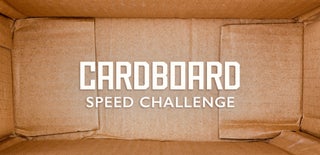Introduction: Cardboard Core Pens
I got a new set of frying pans and in between them, to keep them from scratching each other, was a square of cardboard about 5/8" thick. The cardboard had a nice honeycomb pattern and I wanted to see if I could use this cardboard to make a pen.
Supplies
I used the following:
Cardboard - honeycomb core about 5/8" thick
Epoxy Resin
Chalk-line chalk, both black and blue
Sawdust
Table Saw
CA Glue (Superglue) both medium and thin
Drill Press
Lathe
Scrap wood (I used lychee, but any wood will do)
Boiled Linseed Oil
Vice
Step 1: Filling Cardboard With Resin
After peeling the paper from one side of the cardboard, exposing the honeycomb core, I wrapped blue painter's tape around the perimeter and applied two strips across the top to divide the square into sections.
I mixed a batch of the epoxy and shook up the blue chalk-line chalk to make sure there were no lumps. This bottle was over 10 years old and the lid broke, spraying blue powder all over the shop. I filled two strips with blue epoxy and one strip with epoxy mixed with sawdust.
Step 2: Grab the Fire Extinguisher
I should have quit while I was ahead but I decided to fill in the other two strips with epoxy mixed with black chalk-line chalk. This was a mistake. Epoxy gets hot when it cures and having space between the strips was a good idea. Once I filled these strips in with more epoxy, the whole batch started to heat uncontrollably.
The epoxy heated, boiled, expanded, and smoked. I set it outside and stood by with a fire extinguisher until it was settled down. It looked like a blob of volcanic rock and I may try doing this on purpose for other projects in the future.
Step 3: Rip It Up
I squared up the blob and ripped strips about 5/8" square. The overheated epoxy had expanded, making the resin very porous and easy to cut. The material was about as strong as well toasted bread. I soaked the strips with thin CA glue to make them stronger and then they were more like a stale crouton. I was happy to see the cardboard pattern standing out in the resin.
Step 4: Drill, Glue, Press, Trim
The blanks were drilled to accept brass tubes that come with the standard "slimline" pen kits. These brass tubes are roughed up with sandpaper to allow the glue to bond better. CA glue is used to secure these tubes in place inside the resin and cardboard blanks, then the ends are trimmed flush with the brass tubes. I use a drill press to trim the ends flush, but many use their lathe or a disk sander.
Step 5: To the Lathe
I mounted the first two blanks on the lathe using a pen mandrel. This keeps everything in place while turning on the lathe. After rough turning, I could see the pattern of the cardboard core very clearly and the porous blue resin was interesting (though not what originally intended).
The soft porous resin was quite fragile, and the end of one section "blew out".
Step 6: A Good Craftsman Is Just Good at Hiding Mistakes
I cut out the "blow out" and mirrored this on the other ends of the two blanks.
I drilled and cut four sections of wood from the scrap pile. This was lychee from my Grandpa Kitty's yard.
Secured with CA glue and back to the lathe.
Step 7: Back to the Lathe
I carefully turned the wood to match the resin, then finished shaping both blanks.
Once the shape is there, I apply alternating coats of boiled linseed oil and CA glue while the lathe is running, polishing with a paper towel between each coat. The pattern of the cardboard in the resin really starts to pop when the finish is applied.
Step 8: The Finishing Touches
I pressed the pen fittings in place with the vice. I usually turn pens out of salvaged wood and have never found the right wood to use this blue pen kit. This blue resin and cardboard honeycomb seems like the perfect match.
I'm glad I tried using cardboard as a core material. Some day I'll try again with a more controlled epoxy pour.

Participated in the
Cardboard Speed Challenge









